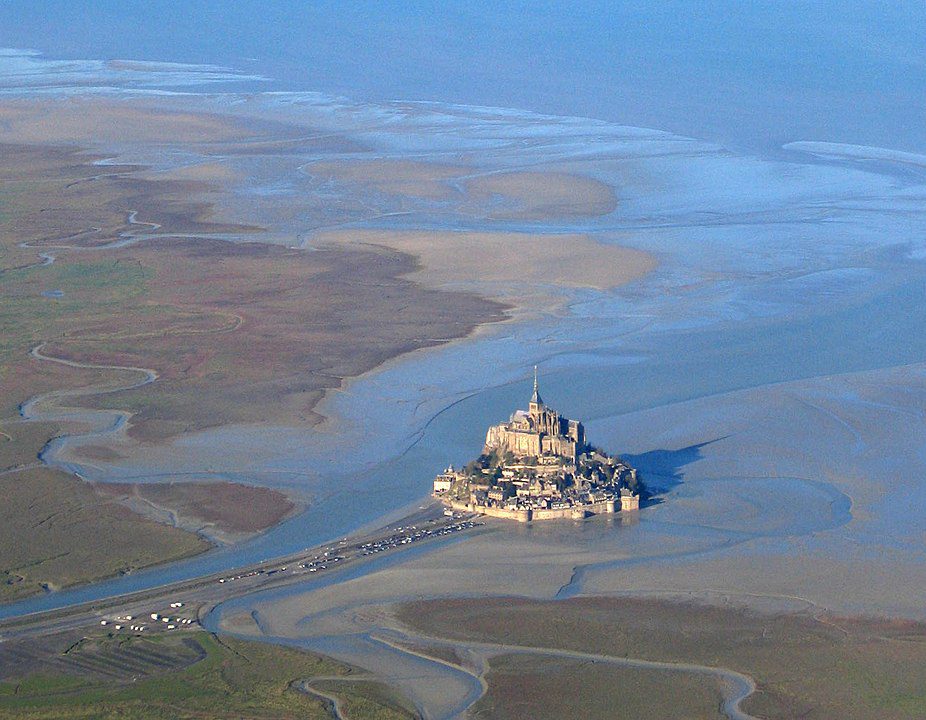
Mont-Saint-Michel is one of the most iconic landmarks in France, renowned for its unique location, medieval charm, and spiritual significance. This extraordinary island commune, located in the Normandy region, rises dramatically from the surrounding tidal flats, creating a stunning silhouette that has captivated visitors for centuries. Its combination of architectural brilliance and natural beauty has earned it a place on the UNESCO World Heritage Site list, and it continues to be a must-visit destination for travelers worldwide.
The site attracts millions of visitors annually who come to marvel at its stunning abbey, explore its quaint medieval village, and witness its breathtaking tidal phenomena. Whether you are drawn to its history, its cultural importance, or its natural setting, Mont-Saint-Michel offers an unforgettable experience. Let’s explore the details of this iconic destination and learn what makes it so extraordinary.
A Brief History of Mont-Saint-Michel
Mont-Saint-Michel has a history as dramatic as its appearance, stretching back to the early 8th century. According to legend, the Archangel Michael appeared to Aubert, Bishop of Avranches, in a series of visions in 708 AD. The angel instructed Aubert to construct a sanctuary on the rocky island. Initially, a small church was built, but over the centuries, it grew into the grand abbey we see today, reflecting the enduring religious significance of the site.
The strategic location of Mont-Saint-Michel also played a pivotal role in its development. During the Middle Ages, it became an important center of learning and pilgrimage, attracting monks, scholars, and travelers from across Europe. The abbey’s construction continued for centuries, incorporating a mix of Romanesque and Gothic architectural styles that speak to the artistic and engineering achievements of their times.
The Medieval Masterpiece
The construction of Mont-Saint-Michel Abbey, spanning from the 10th to the 16th centuries, showcases the evolution of medieval architectural styles. Its Romanesque foundations form a solid base, while the later Gothic additions soar skyward, creating an ethereal quality that has earned it the nickname “The Marvel.” The complex design reflects the challenges of building on such a precarious site, with tiers of structures rising in harmony with the rocky terrain.
The abbey was not only a religious center but also a fortress during the Hundred Years’ War. Its walls and fortifications were ingeniously designed to repel invaders, and despite numerous English attempts to seize it, Mont-Saint-Michel remained unconquered. This resilience added to its mystique and cemented its reputation as a symbol of French national pride.
Cultural and Religious Significance
Mont-Saint-Michel’s religious importance has endured for over a millennium. Dedicated to Saint Michael, the archangel who symbolizes the triumph of good over evil, the abbey became one of Christianity’s major pilgrimage destinations. Pilgrims, often traveling great distances on foot, sought spiritual solace and blessings within its sacred walls.
The site’s cultural impact extends beyond religion. Mont-Saint-Michel has inspired countless artists, writers, and historians, who have celebrated its beauty and significance in various works. Today, it remains a place of spiritual reflection for many, as well as a fascinating historical site for visitors of all faiths.
A Decline and Revival
The French Revolution marked a turning point for Mont-Saint-Michel. Stripped of its religious functions, the abbey was converted into a prison, housing political dissidents and criminals. This period of neglect took a toll on the structure, and by the early 19th century, its future was uncertain. However, efforts to preserve and restore the site began in earnest in the mid-1800s, driven by a renewed appreciation for its historical and cultural value.
In 1979, Mont-Saint-Michel was recognized as a UNESCO World Heritage Site, underscoring its global importance. Today, restoration efforts continue to ensure that this iconic landmark remains a treasure for future generations. Its revival serves as a testament to the enduring allure and significance of this extraordinary site.
The Stunning Architecture
Mont-Saint-Michel’s architectural brilliance is one of its defining features, blending religious, defensive, and aesthetic elements. Its design reflects centuries of adaptation to the challenging environment, with the abbey perched at the summit and the village cascading down the rocky slopes below.
The Abbey
The Abbey of Mont-Saint-Michel, located at the highest point of the island, is the centerpiece of the complex. Its construction is an engineering marvel, considering the limited space and the difficulty of transporting materials to the island. The abbey’s towering spire, crowned with a gilded statue of Saint Michael, dominates the skyline, symbolizing the connection between heaven and earth.
The cloister is another highlight of the abbey. This tranquil, open-air space features a series of elegant arches supported by slender columns, arranged in such a way that they create an illusion of infinite depth when viewed at certain angles. The cloister served as a place of meditation for monks, and today, it offers visitors a sense of serenity and breathtaking views of the surrounding bay.
Below the cloister lies the refectory, the dining hall where monks gathered for meals. The high, vaulted ceilings of the refectory not only lend it an air of grandeur but also serve a practical purpose by amplifying sound, ensuring that readings or prayers could be heard clearly during the monks’ silent meals. These architectural details reflect the ingenuity of the medieval builders and their commitment to creating spaces that harmonize functionality with spiritual purpose.
The Ramparts
Encircling Mont-Saint-Michel are a series of ramparts and defensive towers, built to protect the island from invaders. These fortifications showcase the site’s dual role as both a spiritual sanctuary and a military stronghold. Walking along the ramparts is like stepping back in time; the thick stone walls, arrow slits, and watchtowers evoke the tensions of the medieval period.
The ramparts also provide some of the best vantage points for panoramic views of the surrounding bay and countryside. At high tide, the island appears to float on water, while at low tide, the vast expanse of sand and tidal flats stretches out as far as the eye can see. These views, combined with the historic ambiance, make the ramparts a favorite spot for photographers and history enthusiasts alike.
The Village
At the base of the abbey lies the charming medieval village of Mont-Saint-Michel. This quaint settlement, with its narrow, winding streets and half-timbered houses, transports visitors to a bygone era. The village is filled with artisan shops offering unique souvenirs, such as handmade jewelry, local artwork, and Norman delicacies like biscuits and caramel.
The village also features a variety of restaurants and cafés, many of which specialize in regional cuisine. Visitors can enjoy a meal or a drink while soaking in the historic surroundings. Despite its small size, the village is brimming with life and offers a unique glimpse into what daily life might have been like centuries ago.
The Magic of Tides
One of the most remarkable features of Mont-Saint-Michel is its tidal phenomenon, which transforms the island’s appearance throughout the day. The tides in this region are among the highest in Europe, with differences of up to 14 meters (46 feet) between high and low tide. This dramatic change creates a dynamic and ever-changing landscape that is truly mesmerizing.
At low tide, Mont-Saint-Michel is surrounded by expansive sand flats, allowing visitors to walk around the island and explore the bay. However, the sand can be treacherous, with areas of quicksand that make guided tours essential for safety. During high tide, the sea rushes in and encircles the island, making it appear as though it is floating. Watching the tide come in is a captivating experience and one of the highlights of any visit.
The Science Behind the Tides
The unique tidal phenomenon at Mont-Saint-Michel is caused by the interaction of the Atlantic Ocean’s currents and the shallow nature of the bay. The bay’s funnel-like shape amplifies the tides, creating rapid and dramatic changes. The tides are also influenced by the phases of the moon, with the highest tides occurring during full and new moons. Understanding the science behind the tides adds another layer of appreciation to the spectacle.
Planning Around the Tides
Timing is everything when it comes to experiencing the tides at Mont-Saint-Michel. Visitors are encouraged to check tide schedules in advance to witness the full range of changes. Guided tours of the bay are best scheduled during low tide, while high tide offers the perfect opportunity to see the island at its most picturesque. Careful planning ensures you won’t miss this natural wonder.
Safety Considerations
Exploring the tidal flats is a popular activity, but it’s not without risks. The quicksand and rapidly changing water levels can be dangerous for those unfamiliar with the area. Hiring a licensed guide is essential, as they can navigate the safest paths and provide fascinating insights into the region’s geology and ecology. Additionally, visitors should always follow posted warnings and local advice to ensure a safe and enjoyable experience.
How to Get There
Reaching Mont-Saint-Michel is straightforward, with options for travelers coming from various parts of France and beyond. Its accessibility makes it a popular destination for day trips or extended stays, whether you’re traveling by car, train, or other means. Proper planning is essential to make the most of your visit.
By Car
For those traveling by car, Mont-Saint-Michel is well-connected by highways and regional roads. From Paris, it’s approximately a 4-hour drive, while the journey from cities like Rennes or Caen takes about 1.5 to 2 hours. Visitors can park their vehicles at designated parking lots located on the mainland, about 2.5 kilometers (1.5 miles) from the island. From there, free shuttle buses (called “Passeur”) or a scenic walking path leads to the entrance of Mont-Saint-Michel.
Driving offers the flexibility to explore nearby Normandy and Brittany regions, known for their picturesque landscapes and historical sites. Many visitors combine a trip to Mont-Saint-Michel with stops at places like the D-Day beaches or the charming town of Saint-Malo, enriching their overall experience.
By Train
Trains are a convenient option for those preferring public transportation. From Paris, take a train to Rennes or Pontorson. Rennes offers high-speed TGV trains, which can shorten travel time significantly. Once in Rennes, a direct shuttle bus connects visitors to Mont-Saint-Michel. Alternatively, Pontorson is the nearest train station to the site, located just 9 kilometers (5.6 miles) away. Shuttle buses or taxis are available from Pontorson to the mount.
Traveling by train is particularly appealing for those seeking a stress-free journey. It allows visitors to sit back, relax, and enjoy the scenic views of the French countryside. It’s also a more eco-friendly option compared to driving.
By Bike or Foot
For adventurous travelers, cycling or hiking to Mont-Saint-Michel is an unforgettable experience. The surrounding countryside offers picturesque routes, with well-marked trails for both cyclists and walkers. The journey is particularly rewarding during spring or autumn, when the weather is mild and the scenery is at its best.
Cyclists can park their bikes near the shuttle stop on the mainland, as bicycles are not permitted on the island itself. Hikers can follow long-distance trails, such as the GR34, which traces the coast of Brittany and leads to Mont-Saint-Michel. These options are ideal for those who want to immerse themselves in the natural beauty of the region.
What to Do at Mont-Saint-Michel
Mont-Saint-Michel is brimming with activities and attractions, ensuring there’s something for everyone. From exploring the abbey to savoring local cuisine, each experience offers a deeper connection to the history and culture of this unique destination.
1. Explore the Abbey
The abbey is the crown jewel of Mont-Saint-Michel and a must-visit for all travelers. A guided tour or audio guide enhances the experience, providing insights into the site’s history, architecture, and religious significance. Visitors can wander through grand halls, admire intricate carvings, and stand in awe of the Gothic choir’s towering arches.
In addition to its architectural beauty, the abbey offers unparalleled views of the surrounding bay. Climbing to the top is well worth the effort, as the panorama stretches across the tidal flats and beyond. The sense of peace and reverence within the abbey makes it a highlight of any visit.
2. Witness the Tides
Experiencing the tides is one of the most magical aspects of visiting Mont-Saint-Michel. The transition from low tide to high tide is mesmerizing, as the island transforms from being surrounded by sand to being encircled by water. Watching the tides come in or recede is a spectacle that showcases the power and beauty of nature.
Visitors can plan their visit around the tide schedule to fully appreciate this natural phenomenon. Many choose to arrive during low tide to explore the bay, followed by high tide to see the island at its most dramatic. Each phase offers a unique perspective, making it worth experiencing both.
3. Stroll the Village
The medieval village at the base of Mont-Saint-Michel is a delight to explore. Its narrow streets are lined with charming shops, selling everything from handmade crafts to regional specialties like apple cider and salted caramel. The village’s small museums and historic buildings add to its appeal, offering a glimpse into life on the island throughout the centuries.
Visitors can also discover hidden corners and quiet spots within the village, away from the main tourist areas. Whether you’re browsing for souvenirs, enjoying a meal, or simply soaking in the atmosphere, the village offers a memorable experience.
4. Enjoy Norman Cuisine
Food is an integral part of any visit to Mont-Saint-Michel. The island is home to several restaurants and cafés, many of which serve traditional Norman dishes. The famous fluffy omelets at La Mère Poulard are a must-try, as is the fresh seafood, including mussels and oysters harvested from the surrounding waters.
Pairing your meal with local cider or Calvados, a traditional apple brandy, adds an authentic touch to your dining experience. Whether you’re indulging in a gourmet feast or savoring a simple crepe, the flavors of Normandy are sure to leave a lasting impression.
5. Capture Stunning Photos
Mont-Saint-Michel is a photographer’s dream, offering countless opportunities for capturing its beauty. The best times for photography are sunrise and sunset when the light bathes the island in a golden glow. The tidal flats, with their shimmering reflections, provide a dramatic foreground for photos of the abbey and village.
For unique perspectives, consider photographing the mount from the mainland, the ramparts, or even the nearby surrounding trails. Whether you’re using a professional camera or a smartphone, the island’s timeless charm ensures your photos will be spectacular.
Where to Stay and Eat
Visiting Mont-Saint-Michel is an experience best complemented by thoughtful accommodations and sampling the region’s culinary delights. Whether you choose to stay on the island itself or in nearby towns, your lodging and dining options will enhance your trip to this iconic destination.
Accommodations on Mont-Saint-Michel
Staying overnight on Mont-Saint-Michel is a unique experience that allows you to enjoy the island after the daytime crowds have dispersed. Several small hotels within the medieval village provide cozy, character-filled accommodations. Properties like La Vieille Auberge and Hôtel Croix Blanche offer stunning views and an intimate glimpse into life on the mount.
Guests staying on the island can enjoy the tranquility of walking its cobblestone streets under the moonlight or watching the tides shift from the comfort of their rooms. However, accommodations are limited, so booking well in advance is essential, particularly during peak tourist seasons.
Nearby Accommodations
For those seeking more options or budget-friendly alternatives, nearby towns like Pontorson, Avranches, and Saint-Malo provide a range of hotels, bed-and-breakfasts, and vacation rentals. These locations offer convenient access to Mont-Saint-Michel while also serving as gateways to explore Normandy and Brittany. Many of these towns are steeped in history and provide their own charm, making them worthy stops in their own right.
Accommodations in these towns often include modern amenities and more spacious rooms compared to those on the island. Whether you’re traveling as a family or on a romantic getaway, staying nearby allows you to combine the magic of Mont-Saint-Michel with the comforts of the mainland.
Dining on Mont-Saint-Michel
Mont-Saint-Michel’s culinary scene is deeply rooted in Normandy’s traditions. One of the island’s most famous dishes is the fluffy omelet served at La Mère Poulard, a restaurant that has been serving visitors since 1888. These omelets, cooked to perfection over an open flame, are a local specialty not to be missed.
Seafood is another highlight, with fresh mussels, oysters, and fish featured prominently on menus. Many restaurants, such as Auberge Saint-Pierre, offer dishes that highlight the flavors of the sea, paired with locally sourced produce. Traditional Norman desserts like salted butter caramel and apple tarts make the perfect end to a meal.
Nearby Dining Options
For a broader range of dining options, head to the surrounding towns where you’ll find traditional creperies, bistros, and fine dining establishments. Pontorson, for example, boasts several excellent restaurants that serve hearty Norman fare, while Saint-Malo is known for its fresh seafood and picturesque waterfront settings.
Local markets in these towns are also a great way to sample regional specialties. From creamy cheeses like Camembert and Pont-l’Évêque to freshly baked bread and cider, the local flavors are sure to delight your palate.
Practical Tips for Visitors
A visit to Mont-Saint-Michel is a magical experience, but a little preparation goes a long way toward ensuring a smooth and enjoyable trip. From timing your visit to navigating the island, these practical tips will help you make the most of your journey.
Best Time to Visit
Mont-Saint-Michel is open year-round, but the best times to visit are during spring (April to June) and autumn (September to October). During these seasons, the weather is mild, and the crowds are thinner compared to the busy summer months. Early mornings and evenings are particularly serene, offering a chance to explore without the bustling crowds.
Special events, such as light shows at the abbey during summer, can add a unique dimension to your visit. However, be prepared for more tourists during these events and plan accordingly to secure tickets and accommodations.
Booking Tickets in Advance
The abbey is the centerpiece of Mont-Saint-Michel, and purchasing tickets in advance is highly recommended, especially during peak seasons. Online booking allows you to skip the long queues and enjoy more time exploring the site. Guided tours are also available and can provide valuable insights into the history and architecture of the abbey.
Consider purchasing combination tickets that include entry to nearby attractions in Normandy, such as the D-Day beaches or the Bayeux Tapestry Museum. These packages can save time and money while enriching your overall travel experience.
What to Wear
Comfortable clothing and sturdy footwear are essential for navigating Mont-Saint-Michel. The island’s steep streets, uneven cobblestones, and numerous stairs require good shoes, while layered clothing is recommended due to the area’s unpredictable weather. Even on sunny days, the coastal winds can be chilly, so bringing a light jacket or sweater is a good idea.
During rainy weather, waterproof gear and a small umbrella will come in handy. Be mindful that the abbey’s interiors can be cooler than expected, making an extra layer useful even in summer.
Accessibility
While Mont-Saint-Michel is a wonder to behold, its steep terrain and historic architecture can pose challenges for visitors with mobility issues. The village streets and abbey are not fully wheelchair accessible, and many areas require climbing stairs. However, the lower parts of the village and the shuttle buses are accessible, allowing visitors to enjoy parts of the experience.
For those needing assistance, consider hiring a private guide or contacting local services that specialize in accommodating travelers with special needs. With a bit of planning, Mont-Saint-Michel can still be an enriching destination for all.
Key Takeaways
- Mont-Saint-Michel blends history, culture, and natural beauty in one of France’s most iconic destinations.
- Staying on the island or in nearby towns offers unique perspectives and experiences, with options to suit every budget.
- Witnessing the tides and exploring the abbey are must-do activities, but proper planning is key to maximizing your visit.
- Sampling regional cuisine, from seafood to traditional Norman desserts, adds an extra layer of enjoyment to your trip.
- Prepare with appropriate clothing, advance tickets, and safety precautions to ensure a seamless and memorable adventure.
FAQs
- What is the best way to explore Mont-Saint-Michel?
Exploring on foot is the best way to experience Mont-Saint-Michel. Guided tours enrich the experience, particularly in the abbey and surrounding bay. - Can you stay overnight on Mont-Saint-Michel?
Yes, there are several charming hotels on the island, but accommodations are limited, so booking early is essential. - Are guided tours necessary for exploring the tidal flats?
Absolutely. Guided tours ensure safety and provide valuable insights into the bay’s ecology and quicksand areas. - Is Mont-Saint-Michel family-friendly?
Yes, but families with young children should be prepared for steep climbs and uneven paths. The abbey might be challenging for strollers. - What are some nearby attractions to visit?
Nearby attractions include the towns of Saint-Malo and Avranches, as well as Normandy’s D-Day beaches and the Bayeux Tapestry Museum.




